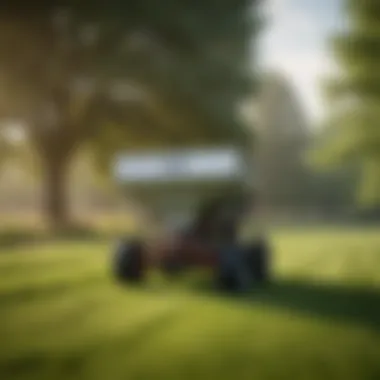Broadcast Spreader Settings for Effective Grass Growth


Intro
Applying grass seed correctly is fundamental for successful lawn care. To achieve this, using a broadcast spreader with the right settings is crucial. This detailed guide will delve into the essential concepts, settings, and techniques for utilizing a broadcast spreader effectively. It will also address the significance of precision in the spreading process. Understanding how to adjust these settings can lead to optimal grass growth and coverage, which is the ultimate goal for both professional agronomists and gardening enthusiasts.
Key Concepts and Terminology
Basic Definitions
A broadcast spreader is a device that distributes seeds or fertilizers evenly across a designated area. It works by throwing the material in a wide arc, which can cover a large space quickly. It's important to differentiate between the two main types of spreaders:
- Drop Spreaders: These place the material directly below the spreader, allowing for precise application.
- Broadcast Spreaders: These propel the seeds or fertilizer outward from a central point, ensuring a broader application area.
Historical Context
The use of seed spreaders dates back many centuries. Initially, manual techniques dominated, with farmers using handheld equipment. The invention of mechanical spreaders revolutionized the farming industry, allowing for more efficient application. As awareness of the environmental impacts of lawn care increased, innovations in spreader technology emerged, focusing on targeted application and waste reduction.
Recent Innovations and Trends
Technological Advancements
Modern broadcast spreaders come equipped with features such as adjustable settings for different types of seeds and a variety of spreading patterns. Some advanced models even have GPS-enabled tracking to ensure precision in application. Electronic spreaders are also becoming more common, which can automate the process, minimizing human error.
Sustainable Practices
As farmers and gardening enthusiasts have become more eco-conscious, there is a strong push for sustainable practices. Using a broadcast spreader with the right settings ensures minimal over-application and reduces waste. Certain brands now offer products that facilitate this, designed specifically for organic or environmentally friendly materials.
Practical Applications and Techniques
Step-by-step Guides
When using a broadcast spreader, the following steps can enhance effectiveness:
- Select the Right Spreader: Choose between a drop or broadcast spreader based on your needs.
- Calibrate the Spreader: Adjust the setting according to the type of seed. This often involves consulting the manufacturer’s guidelines.
- Conduct a Test Run: Before applying seeds to the entire area, perform a small test to check for even distribution.
- Apply in Overlapping Passes: Ensure overlapping passes to achieve uniform coverage, especially in corners and edges.
- Clean the Equipment: After use, clean the spreader to prevent clogs and ensure longevity.
Case Studies
For practical insight, consider the example of a community park that underwent a complete lawn renovation. The managers used detailed calibration on their broadcast spreader and applied a special blend of grass seed suited for local conditions. As a result, they achieved even growth across the park and reduced the need for re-seeding in the following seasons.
Proper calibration and care of your broadcast spreader can significantly impact lawn health and aesthetics.
Preface to Broadcast Spreaders
Broadcast spreaders play a crucial role in the application of grass seed. They ensure that seeds are distributed evenly across a given area, which is necessary for uniform growth. Without proper dispersal, some areas may become dense while others remain bare, leading to patchy lawns. Understanding how broadcast spreaders function helps in achieving the best results in lawn care and maintenance.
Efficient use of a broadcast spreader can significantly impact the success of grass establishment. In this section, we will define what broadcast spreaders are, explore the types available in the market, and discuss their particular benefits. Each of these aspects informs users of their choices and empowers them to make informed decisions for their seeding projects.
Definition of Broadcast Spreaders
A broadcast spreader is a garden tool designed to distribute seed, fertilizer, or other granular materials evenly over a wide area. It typically features a hopper that holds the material and a mechanism to release it as the user walks or as it is towed. As the name implies, these spreaders broadcast the material in a wide pattern, covering substantial ground.
Types of Broadcast Spreaders
Several types of broadcast spreaders exist, each designed for specific needs and preferences. Understanding their differences can guide a user in selecting the most suitable type for a given environment and task.
Push Spreaders
Push spreaders are manually operated tools pushed by the user. They are generally user-friendly and suitable for residential lawns. One key characteristic of push spreaders is their adjustable rate settings, allowing users to control the amount of seed or fertilizer dispensed. This feature is beneficial for achieving precise application rates, ensuring that no area receives excessive material.
A unique feature of push spreaders is their mechanical construction, often equipped with a simple, wheel-driven mechanism that activates the spreader as the user moves. Their advantages include ease of use and affordability. However, their limitation lies in their practicality on larger lawns, where towing options may be more efficient.


Tow-Behind Spreaders
Tow-behind spreaders are designed for larger areas and are towed behind a lawn tractor or ATV. Their main advantage is the increased capacity compared to push spreaders. This characteristic allows them to cover greater distances without frequent refills. Moreover, tow-behind spreaders often possess larger hoppers, which means they can manage bigger jobs efficiently.
A significant feature of tow-behind spreaders is their strong construction, suitable for heavy-duty use. However, they may require more storage space and can be more expensive than push-type models. Users must also ensure their towing vehicle has proper capacity and capabilities.
Handheld Spreaders
Handheld spreaders are compact and ideal for small areas or tight spaces. They are lightweight and easy to maneuver, making them a good choice for gardeners with limited space. One notable characteristic is their portability, allowing users to carry them easily without requiring any machinery.
A unique advantage of handheld spreaders is their precision. They allow for targeted distribution, which is critical when working in confined areas such as flower beds or patches of grass. However, their limitations include a smaller capacity, meaning users may need to refill more often compared to larger alternatives.
In summary, each type of broadcast spreader offers unique features that cater to specific lawn care needs. Understanding these differences helps users select the appropriate spreader for grass seed application, which ultimately leads to healthier, more vibrant lawns.
Understanding Grass Seed Characteristics
Understanding grass seed characteristics is essential for effective broadcast seeding. The types of grass seeds and their specific features directly affect their growth rates, resilience to local climate conditions, and general maintenance needs. This knowledge helps in selecting the appropriate seed based on the desired lawn type and use, ensuring a successful establishment. Moreover, recognizing the differences in seed characteristics aids in making informed decisions regarding spreader calibration, which is crucial for achieving optimal results.
Types of Grass Seeds
Cool-Season Grasses
Cool-season grasses are typically planted in the northern regions, flourishing in cooler temperatures and experiencing peak growth during the spring and fall. This type of grass includes popular varieties such as Kentucky bluegrass and tall fescue. These grasses are favored for their vibrant color and dense growth, making them a beneficial choice for residential lawns. The primary characteristic of cool-season grasses is their ability to thrive in temperatures between 60°F and 75°F.
The unique feature of cool-season grasses is their deep root systems, which provide greater drought resistance. However, they can struggle to maintain health during extreme heat. Therefore, while cool-season grasses are advantageous in milder climates, they may require more water during summer months.
Warm-Season Grasses
Warm-season grasses are more suitable for southern climates. They grow optimally in temperatures ranging from 80°F to 95°F and include varieties such as Bermuda grass and Zoysia grass. A key characteristic of warm-season grasses is their growth period, which primarily occurs during the warmer months, resulting in a lush lawn during summer.
The unique feature of warm-season grasses is their drought tolerance and lower water needs once established. They can endure higher heat levels better than cool-season counterparts. However, warm-season grasses may enter dormancy in cooler temperatures, leading to brown patches during winter. Hence, they are a popular choice in regions where summer heat is predominant but might not be as well-suited for areas with pronounced seasonal temperature drops.
Seed Size and Weight
The size and weight of grass seeds can significantly impact the spreading process and the overall establishment success. Larger seeds often have higher energy reserves, which may promote better germination rates while smaller seeds tend to disperse more easily and cover wider areas. In addition, understanding the weight of the seeds plays a role in setting the broadcast spreader correctly. Accurate setting is necessary to avoid uneven coverage that can lead to patchy growth and inefficient lawn coverage.
Factors Influencing Spreader Settings
Understanding factors that influence spreader settings is critical for effective grass seed application. These elements directly impact how evenly and appropriately the seeds are distributed across the lawn. When the settings are correct, the resultant growth and coverage can meet or even exceed expectations.
Seed Dispersion Patterns
Seed dispersion patterns can vary based on the design of the broadcast spreader. The spacing and shape of the spreader’s opening play a role in determining how seeds are scattered. A well-designed spreader can offer a uniform distribution, ensuring that each seed gets optimal exposure to soil, light, and moisture. Ensuring a proper setting that suits the seed mix can lead to more lush growth. To achieve this pattern, users often need to experiment with settings prior to large applications.
Environmental Conditions
Environmental conditions are pivotal in determining the effectiveness of seed application. Factors such as wind speed, humidity, and soil moisture can alter how seeds are delivered and subsequently germinate.
Wind Speed
Wind speed can significantly affect seed dispersal. High winds can carry seeds away from the intended area, leading to uneven distributions and waste. On the other hand, low wind conditions help maintain accuracy in spreading. When using a broadcast spreader, it is beneficial to check local wind conditions before commencing. Using a spreader in high winds might require a reevaluation of application rates, leading to inefficiency and potential over-application.
Humidity
Humidity levels can influence the moisture content of seeds and soil. High humidity may help the seeds adhere better to the soil, but it can also create a risk of fungal growth. Thus, understanding the level of humidity is crucial. A moderate humidity level is generally favorable for spreader operations. This ensures seeds remain settled in soil rather than washed away during subsequent rainfall.
Soil Moisture
Soil moisture is another critical consideration. Properly moist soil can enhance seed-to-soil contact, promoting germination. If the soil is too dry, seeds may struggle to establish roots. Conversely, overly saturated soil can lead to seed rot. As such, checking the moisture level of the soil before application is essential. Depending on the existing conditions, adjusting broadcast spreader settings to allow for different application rates might be necessary to ensure optimal results.


Purpose of Seeding
The purpose of seeding largely influences the needed settings on a broadcast spreader. There are different strategies depending on whether one is starting a new lawn installation or overseeding an existing lawn.
New Lawn Installation
When establishing a new lawn, spreader settings need to be calibrated for optimal seed application. New lawns require a thicker seed coverage to ensure that sufficient plants can grow. Therefore, a higher seed rate might be necessary. Users should account for the type of grass and soil conditions, optimizing the spreader settings accordingly. A heavier application assists in quick establishment, but care should be taken to avoid over-seeding, which can lead to competition among seedlings.
Overseeding Existing Lawns
For overseeding, the goal is different. It involves introducing new seedlings into an existing lawn to improve density, repair damage, or update the grass variety. Therefore, the spreader settings typically call for a lighter seed application. Unlike new installations, overseeding requires careful calibration to ensure that healthy grass remains. Adjusting the spreader to a lower setting protects existing plants from being overshadowed or overwhelmed by new growth. This delicate balance is essential for sustaining the lawn's health and diversity.
Proper calibration according to purpose can greatly increase the success of grass establishment and improve overall lawn quality.
By understanding these various factors, users can achieve more successful grass seed applications. Adapting to the conditions and purpose allows for effective lawn care practice, leading to vibrant, healthy lawns.
Calibration of Broadcast Spreaders
Calibration of broadcast spreaders is crucial for achieving optimal results when applying grass seed. The act of calibrating ensures that the correct amount of seed is being distributed uniformly across the intended area. This process can significantly impact the growth and establishment of the grass. When calibration is done properly, it helps reduce waste, minimizes competition among seeds, and promotes a healthy lawn.
Importance of Calibration
Calibration is the backbone of an effective seeding strategy. If the spreader is not calibrated correctly, you may end up with uneven applications. This can result in patchy growth, areas where grass fails to establish, and even over-seeding which can choke young seedlings. Furthermore, the accuracy in calibration directly affects your resources. Wasting seed is not cost-effective. Also, improper settings can lead to additional work such as re-seeding or patching bare spots. Therefore, understanding the importance of calibration enables both efficiency and effectiveness in lawn care.
Step-by-Step Calibration Process
Selecting the Right Setting
Selecting the right setting on your broadcast spreader is essential. It involves determining the appropriate opening size for the spreader. Each type of grass may have different requirements for seed dispersion. Remember, this choice reflects on how evenly you will distribute the seed. A key characteristic of selecting the right setting is the ability to refer to the manufacturer’s recommendations. Most seed packages will have guidelines for settings. While this is a popular method, one must consider local variables such as soil conditions and moisture levels, which could impact the final result.
Testing Dispersion
Testing dispersion is the practical step to verify if your spreader setting is accurate. This process involves making a test run over a predefined area, observing how the seeds disperse. A key characteristic here is that it offers a real-time view of your settings in action. If you see clumping or uneven distribution, it indicates adjustments are necessary. This method provides a tangible measurement of your calibration effort. It makes you aware of potential flaws in the initial setting. However, it can consume some additional time, but is worth the effort for solid results.
Adjusting Settings According to Results
Adjusting settings according to the results of your test run is vital for success. After observing how the seed is spread, you may find that the initial setting is not leading to an even distribution. This step involves fine-tuning the spreader setting, increasing or decreasing the opening size based on what you have seen. A key characteristic of this process is that it requires an iterative approach. This means you may need to repeat the testing phase several times to achieve the desired outcome. While it could prolong the calibration process, the end result can be dramatically improved grass growth and establishment.
Recommended Calibration Tools
Calibrating a broadcast spreader can be made easier with the right tools. Recommended tools include:
- Measuring tape to measure out test areas accurately.
- Seed scale to weigh out exact amounts of seed before application.
- Calibration chart which provides a reference for average settings based on seed type.
- Notebook where you record settings and observations during the calibration process.
Using these tools can streamline the calibration process, ensuring a more efficient application of grass seed and ultimately leading to a healthier lawn.
Setting Application Rates
Setting application rates is crucial for ensuring that grass seed is spread evenly over the lawn, promoting healthy growth and establishment. Getting this right influences not only the initial growth but also the overall health and aesthetics of your grass. When application rates are within optimal ranges, grass seeds have a better chance to germinate without the competition from excessive growth. Thus, it is necessary to understand how to determine these rates effectively.
Determining Seed Application Rates
Determining seed application rates starts with understanding the type of grass seeds being used. Each grass variety has its recommended seeding rate, often found on the seed bag. Additionally, awareness of the lawn's size and its conditions can also influence how much seed is needed. The home gardening enthusiasts and farmers should write down the seed density, which can help create a plan for appropriate application rates.
When determining the rate, consider factors such as:
- Seed Type: Different seeds have varying requirements. For instance, Kentucky Bluegrass usually requires about 2 to 3 pounds per 1,000 square feet, while tall fescue often necessitates 5 to 8 pounds per 1,000 square feet.
- Desired Lawn Thickness: A thicker, more robust lawn will require a higher rate compared to one intended for light use.
- Existing Lawn Condition: If overseeding, a lighter application is often more suitable so as not to smother existing grass.
By calculating accurately, one can ensure that there are not too many or too few seeds applied to the lawn, thus facilitating a healthier and more resilient grass growth.


Calculating Coverage Area
Calculating the coverage area is essential for translating the determined application rates into practical steps. To begin, measure the entire lawn area in square feet. This can be done by using the formula:
- Area = Length x Width
If the yard is irregularly shaped, divide it into manageable geometric areas, calculate those separately, and then add them together. For example, if one section is rectangular and another is circular, apply the rectangle formula for the rectangular section and use the circle formula (Area = πr²) for the circular section.
Once the area is known, one can determine how much seed will be needed based on the recommended rates previously identified. For instance, if one has a 1,000 square foot lawn and the desired application rate for a specific grass type is 4 pounds per 1,000 square feet, then:
- Total Seed Needed = Application Rate x Coverage Area
Here, it translates to needing 4 pounds of seed for that lawn area. By taking such systematic steps, you can avoid common over- or under-application errors that detract from your efforts to cultivate a healthy lawn.
Effective application rates play a vital role in achieving the desired lawn outcome and minimizing waste of resources.
Understanding how to determine seed application rates and accurately calculating coverage area not only enhances lawn care but also promotes sustainable practices in gardening and farming.
Common Mistakes in Settings and Their Consequences
When using broadcast spreaders for grass seed application, understanding potential mistakes is crucial. Proper settings result in effective seed distribution, leading to a healthy lawn. Misinformation or carelessness can lead to poor results, negatively affecting both turf growth and resource use.
Over-Application of Seed
Over-application happens when too much seed is dispensed during a single pass. This can occur due to incorrect spreader settings or not recalibrating after a switch in seed type. The effects of over-application are significant. For one, it can result in overcrowded grass, which competes for nutrients, sunlight, and water. This competition often leads to weaker plants that may be susceptible to diseases.
Additionally, over-seeding increases waste. Excess seed may go unused, especially if it lands in non-favorable conditions. It also raises costs unnecessarily due to buying extra seed. To avoid over-application, users should conduct calibration checks regularly. Keep in mind that specific seed types may require different application rates, and it's essential to adjust the spreader settings accordingly.
Under-Application of Seed
On the other hand, under-application occurs when the seed is not distributed evenly or is applied at a lower rate than recommended. This issue can arise from settings being set too low, or the spreader being used incorrectly. The consequences are equally detrimental; grass may grow sparse and thin, leaving bare spots which can lead to erosion and weed invasion.
When under-application happens, not only does it affect the visual appeal of the lawn, but it also creates additional work. Homeowners may find themselves re-seeding areas, leading to more labor and further financial expenditure. To prevent under-application, it’s advisable to follow proper calibration methods mentioned in earlier sections. Regularly assess the seed coverage achieved and adjust the settings as needed to maintain optimal rates.
Maintaining Your Broadcast Spreader
Maintaining your broadcast spreader is vital for optimizing its performance and extending its usable life. Neglecting maintenance can lead to uneven seed distribution, which negatively impacts grass growth and coverage. A well-cared-for spreader ensures precise applicatio of seed and a better return on your investment. Regular checks and maintenance tasks can prevent mechanical issues and minimize the need for repairs.
Routine Maintenance Tasks
Engaging in routine maintenance tasks for your broadcast spreader can significantly improve its functionality and longevity. Here are several key tasks to consider:
- Cleaning After Use: It is essential to rid the spreader of any debris, seed remnants, or fertilizer particles that may cling to the spreader components after use. A simple wash with water and a soft brush can prevent build-up and corrosion.
- Inspecting the Parts: Regularly examining key components such as the distribution plate, tires, and hopper helps identify any wear and tear. Early detection of issues allows for timely repairs or replacements, reducing the risk of breakdown while in use.
- Lubricating Moving Parts: Lubrication of the spreader’s moving parts, such as the wheels and mechanisms, minimizes friction and prevents premature wear. Using an appropriate lubricant can also enhance spreading consistency and ease of operation.
- Adjusting Settings: Take the time to check and recalibrate settings according to the seed type and application method. This will ensure optimal performance and coverage when you use the spreader next.
Incorporating these tasks into your regular maintenance routine will help sustain the spreader’s efficiency and reliability over time.
Expected Lifespan of Spreaders
The lifespan of a broadcast spreader can vary based on its type, frequency of use, and maintenance practices. Generally, a well-maintained spreader can last anywhere from five to ten years. Factors that influence this include:
- Quality of Construction: Higher-quality materials typically enhance durability. Models designed for professional use often endure longer than those meant for casual gardening.
- Environmental Conditions: Exposure to harsh weather, such as extreme heat or humidity, can shorten the lifespan of a spreader. Storing the spreader in a sheltered area when not in use is advisable.
- Frequency of Use: Spreaders that are used more often will naturally experience more wear. Regular, proper maintenance becomes crucial in these cases.
By ensuring that you take care of your broadcast spreader, you can maximize its lifespan, save money on repairs, and ensure consistent performance for each application.
The End and Best Practices
Determining the proper settings for a broadcast spreader when applying grass seed is fundamental to achieving a thriving lawn. The ultimate goal of using a broadcast spreader is to ensure an even distribution of seeds, which is essential for consistent growth and establishment. Implementing best practices at this final stage can enhance both efficiency and results. Missteps in settings can lead to uneven coverage, wasted resources, and a patchy lawn, creating unnecessary work for the user. Therefore, adherence to specified guidelines and principles is key.
Recap of Key Points
- Understanding Your Spreader: Knowing the type of broadcast spreader and its specific settings is crucial. Different models have unique calibration and operating features, and familiarity with your tool can save time and effort.
- Seed Selection Matters: Different types of grass seeds have distinct requirements based on factors such as size, weight, and growth patterns. Selecting suitable seeds for your climate and soil type will effectively support successful seeding.
- Calibration for Success: Calibration offers an accurate application rate that leads to optimal seed dispersal. The step-by-step calibration process ensures readers are fully prepared to make adjustments based on seeds and environmental factors.
- Awareness of Coverage Area: Properly calculating the area needing coverage allows for effective planning. Always consider overlaps to avoid bare spots or over-seeding.
- Maintenance is Key: Regular maintenance of the spreader will prolong its lifespan and performance. Knowledge about the expected lifespan of various spreader types enables proactive care.
Final Recommendations
- Regular Calibration: Make calibration a routine practice. Changes in seed type or environmental conditions necessitate recalibration.
- Monitor Environmental Changes: Be aware of variable conditions like wind and moisture, which impact seed dispersal patterns. Adjust your settings accordingly.
- Test First: Before applying to the entire lawn, conduct a test run in a small area. This practice prevents costly errors.
- Document Your Process: Keep records of settings used for different seeds and conditions. This information will simplify future applications.
Implement the provided best practices, and leave behind the uncertainties associated with seed application. By combining theoretical knowledge with practical experience, a lush, vibrant lawn awaits.















